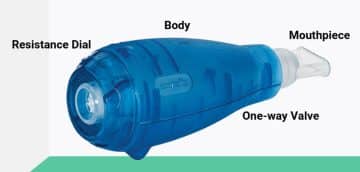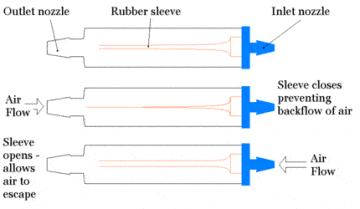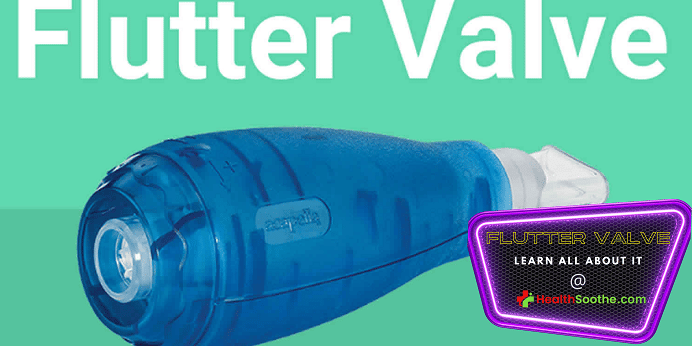About the Flutter Valve

A flutter valve (known as the Heimlich valve since its creator, Henry Heimlich) is a one-way respiratory valve used in respiratory therapy to prevent air from flowing backward via a chest tube.
The flutter valve is a handheld device designed to facilitate the clearance of mucus in hypersecretory lung disorders. Exhalation through the Flutter results in oscillations of expiratory pressure and airflow, which vibrate the airway walls (loosening mucus), decrease the collapsibility of the airways, and accelerate airflow, facilitating the movement of mucus up the airways
Any chest drainage management system, that normally allows for the application of a vacuum as well as the quantification of effluent, may also be used. It is, however, considerably bigger and has more tubing, which might encumber the patient.
To know more on flutter valves, watch the video below:
What is the Flutter Valve used for?
The flutter valve is most commonly used to help remove air from a pneumothorax.1https://en.wikipedia.org/wiki/Flutter_valve A pneumothorax is an abnormal collection of air in the pleural space between the lung and the chest wall. Symptoms typically include sudden onset of sharp, one-sided chest pain and shortness of breath.
In a minority of cases, a one-way valve is formed by an area of damaged tissue, and the amount of air in the space between the chest wall and the lungs increases; this is called a tension pneumothorax.2https://en.wikipedia.org/wiki/Pneumothorax
Indications of Use of the Flutter Valve
Mucus-producing respiratory conditions, including:
- Atelectasis
- Bronchitis
- Bronchiectasis
- Cystic Fibrosis
- Chronic Obstructive Pulmonary Disease (COPD)
- Asthma
- Other conditions producing retained secretions.
Contraindications of Use of the Flutter Valve
- Patients known to have overt right-sided heart failure.
The Mechanism of the Flutter Valve and Procedure for using the Flutter Valve

- The Flutter device consists of a hardened plastic mouthpiece at one end, a plastic perforated cover at the other end, and a valve on the inside created by a high-density stainless-steel ball resting in a plastic circular cone.
- When a subject exhales through the mouthpiece, the ball rolls and moves up and down, creating an opening and closing cycle that repeats itself many times throughout each exhalation.
- The actual position of the ball during exhalation is the result of an equilibrium between the pressure of the exhaled air, the force of gravity on the ball, and the angle of contact of the ball on the cone. The opening and closing cycles produce oscillations of endobronchial pressure and expiratory airflow.
- The maximum endobronchial pressure generated is approximately 20 to 25 cm H20; expiratory pressure varies between 0.8 and 2.5 cm H20 during the opening and closing cycle. Oscillations in airflow result from successive acceleration and deceleration phases that coincide with the opening and closing cycles, producing the "flutter effect."
- The frequency of the oscillations can be modulated by changing the inclination of the Flutter device slightly up or down from its horizontal position. The patient selects the position that results in the greatest "fluttering" (i.e., vibrating) sensation within the chest.3https://www.sciencedirect.com/topics/veterinary-science-and-veterinary-medicine/flutter-valve This is the position at which airway vibration is maximized.
- The vibration of the airways presumably loosens mucus from the airway walls, acceleration of expiratory airflow facilitates the movement of mucus up the airways, and increases in endo-bronchial pressure decrease the collapsibility of the airways during exhalation, increasing the likelihood of clearing mucus from the tracheobronchial tract. This device is small, portable, and easy to use and has no side effects.
- Maximum oscillation can be achieved by moving the flutter slightly up or down.
- The Patient should keep using it until no more mucus can be expectorated.
- Approximately 5 to 15 minutes can be taken to clear secretions.
The valve is often built as a rubber sleeve inside a plastic container, with the rubber sleeve positioned such that when air goes through the valve in one direction, the sleeve opens up and allows the air to pass through.
When the air is drawn back the opposite way, the sleeve shuts and no air is permitted to flow reverse. This design allows it to function as a one-way valve, enabling air (and fluid) to move in just one direction through the drainage tube.
The drainage tube's tip is inserted through the patient's chest cavity, inside the air or liquid to be drained. The pneumothorax is therefore expelled out of the patient's chest when the flutter valve is attached in the proper orientation (most packs are built such that the valve may only be attached in the proper configuration).
Problems Associated with using the Flutter Valve
These valves have a number of possible issues. One issue is the fact that the chest tube might get clogged. When the chest tube becomes clogged, the pneumothorax or subcutaneous emphysema might reoccur.
This may also result in empyema. The second issue is that they have a tendency to leak liquids. Some people have resorted to modest chest drainage options to manage this. Another option is to connect a sputum or phlegm trap to the valve, creating a reservoir to catch the draining fluid.
The limitations of the flutter valve include the following:
- Gravity-dependent machine
- Needs to be cleaned after every session
- Can be used for one patient only
- Requires adequate cognitive function. E.g.: Motivation and Concentration
- Requires adequate motor control which means sitting in the correct position, holding the device at the right angle, and generating adequate expiratory pressure.
Summary
Flutter valves, also known as Pneumostat valves, enable the patient(s) to ambulate more readily and, in certain cases, let them leave the hospital. The typical chest tube collecting box would often need a prolonged hospital stay.
All right, guys, that is it for now for the flutter valve. I hope Healthsoothe answered any questions you had concerning the flutter valve.
Feel free to contact us at contact@healthsoothe.com if you have further questions to ask or if there’s anything you want to contribute or correct to this article. And don’t worry, Healthsoothe doesn’t bite.
You can always check our FAQs section below to know more about flutter valves. And always remember that Healthsoothe is one of the best health sites out there that genuinely cares for you. So, anytime, you need trustworthy answers to any of your health-related questions, come straight to us, and we will solve your problem(s) for you.
A flutter valve (also known as the Heimlich valve after its inventor, Henry Heimlich) is a one-way valve used in respiratory medicine to prevent air from traveling back along a chest tube. This should be done 2-4 times during the course of a day. If you take breathing treatments, the best time to use these devices is after your treatment. This can also be done as needed when you feel like you need to cough but can't seem to bring anything up. The use of a flutter valve for 30 min/d for at least 4 weeks is enough to change physical properties and improve mucus transport by coughing and can contribute to the reduction of the total number of inflammatory cells of the respiratory secretions of subjects with bronchiectasis.Frequently Asked Questions Concerning Flutter Valve
What is a Flutter Valve for Breathing?
How Often Should You Use a Flutter Valve?
How Long Should I Use the Flutter Valve?
I Am odudu abasi a top-notch and experienced freelance writer, virtual assistant, graphics designer and a computer techie who is adept in content writing, copywriting, article writing, academic writing, journal writing, blog posts, seminar presentations, SEO contents, proofreading, plagiarism/AI checking, editing webpage contents/write-ups and WordPress management.
My work mantra is: “I can, and I will”
Additional resources and citations
- 1https://en.wikipedia.org/wiki/Flutter_valve
- 2https://en.wikipedia.org/wiki/Pneumothorax
- 3https://www.sciencedirect.com/topics/veterinary-science-and-veterinary-medicine/flutter-valve
The content is intended to augment, not replace, information provided by your clinician. It is not intended nor implied to be a substitute for professional medical advice. Reading this information does not create or replace a doctor-patient relationship or consultation. If required, please contact your doctor or other health care provider to assist you to interpret any of this information, or in applying the information to your individual needs.


